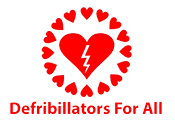Got Questions? We’ve Got Answers!
Below are a range of questions we commonly receive in regards to defibrillators and what they do. Click the question to reveal the answer. If you still have unanswered questions, please head to the contact page or join our Facebook group, displayed on the top of every webpage.
Sudden cardiac arrest (SCA) simply means that the heart unexpectedly & abruptly stops beating. This is usually caused by an abnormal heart rhythm called ventricular fibrillation (VF). The only effective treatment for VF is Defibrillation.
The only effective treatment for VF is an electrical shock called defibrillation. Defibrillation is an electrical current applied to the chest. The electrical current passes through the heart with the goal of stopping the VF and giving an opportunity for the heart’s normal electrical system to take control. This current helps the heart reorganise the electrical activity so it can pump blood again.
An AED (Automated External Defibrillator) is a device that analyses and looks for shockable heart rhythms, advises the rescuer of the need for defibrillation and delivers a shock if needed.
Click the video below for a tutorial.
When used on people who are unresponsive and not breathing, the AED is extremely safe. The AED makes shock delivery decisions based upon the victim’s heart rhythm, and will only defibrillate a shockable rhythm. If the casualty is breathing it will not give a shock.
Do CPR only until the AED arrives. Apply the electrode pads to the victim’s bare chest and follow the voice prompts and messages of the AED. It will tell you when to resume CPR. If someone brings the defibrillator tell them to apply the pads while you continue to perform CPR. The defibrillator will tell you when to stop.
CPR provides some circulation of oxygen rich blood to the victim’s heart and brain. This circulation delays both brain death and the death of heart muscle. CPR also makes the heart more likely to respond to defibrillation.
AEDs are extremely safe when used properly. The electric shock is programmed to go from one electrode pad to another through the victim’s chest. Basic precautions, such a verbally warning others to stand clear and visually checking the area before and during the shock, will ensure the safety of rescuers.
Yes, never withhold the use of an AED on a person with SCA.
It is safe to use a standard defibrillator on a child over the age of 8 (over 25kg).
1 – 8 years
Many manufacturers now supply purpose-made paediatric pads or programmes. These devices are recommended for children between 1 and 8 years up to 25kg. If no such system or manually adjustable machine is available, an unmodified adult AED may be used.
Under 1 year
Although shockable rhythms are extremely unusual in infants (under the age of 1) and the focus of infant resuscitation should be on high quality CPR, there are rare case reports of the successful use of AEDs in this age group. For an infant in a shockable rhythm, the risk: benefit ratio favours the use of an AED (preferably with an attenuator) if a manually adjustable model is not available.
So, where are they?
We’ve created a page that allows users to quickly find where each defibrillator is located, using either the text list or embedded map.

Comments are closed.